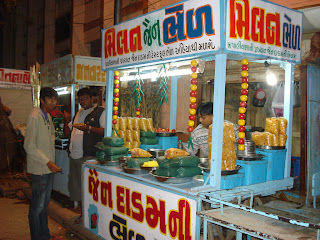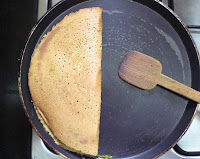I've been a hoarder. Always. And that's what happened with food as well, I've been getting fun stuff from various markets to try out at home, but as is evident from the activity (or the lack of it) on this blog, I've hardly done any justice to the lovely ingredients I have been stocking up on.
Today's meal had to be a quick one, and had to be dished out with whatever was available at home. Of course, with a fully stocked Gujarati (or even Indian) kitchen, there would hardly be any problems, yet I wanted something that we do not eat every day.
A packet of red rice peeped through from underneath the many other packets trying to hide it. I could have made do with a simple dal chawal, but as I mentioned before, nope! So I dug in the fridge - mushrooms and sprouts. The deal was sealed. Mushroom rice with sprouts. Simple. In the end, I thought Chinese flavours would work better, so I threw in a couple of onions as well! Simple and delicious.
Schezuan mushroom red rice with sprouts
Ingredients
Red rice, washed - 1 cupSpring onions, washed and chopped roughly lengthwise - 1/4 cup
Mushrooms, washed and sliced - 1/2 cup
Bean sprouts - 1/4 cup
Coriander (cilantro), washed, chopped roughtly - 2 tablespoons
Garlic, peeled and sliced - 1or 2 cloves
Salt - 1 teaspoon
Schezuan sauce - 2 table spoons
Soy sauce - 1 teaspoon
Oil to cook (or Pam cooking spray) - 1 teaspoon
Method
 |
| Cooked red rice ready to go in the pan |
2. When step 1. is done, heat the oil in a nonstick pan. If using Pam, work accordingly. Saute the garlic and onions for 30 seconds and add the coriander. We are using it as a herb, not a garnish. After a few seconds, add the mushrooms and the beans. Cook only for about a minute till they are lightly done. You do not want to leave it longer, as they will wilt and ooze out liquids.
3. Add the schezuan sauce. I had bottled some from a recipe (see link above) but you could also use a store bought version.
4. Add the rice and salt and mix well. You do not have to cook any more, you just have to mix well.
5. Add the soy sauce and taste it. Adjust salt if you want.
6. Wait no more, devour it, and wash it down with a cold drink!
 |
| Waiting to be attacked |
Notes
- You could use any kind of rice instead of red. But the crunchier version tastes better than white rice.
- To increase spice levels, you could add a couple of green or red chillies.
- No measurements are set in stone, you could alter them to your taste!
- I used only the while of spring onions, since I had no greens. You can use both, and substitute with a regular onion if you do not have spring onions at home.

































